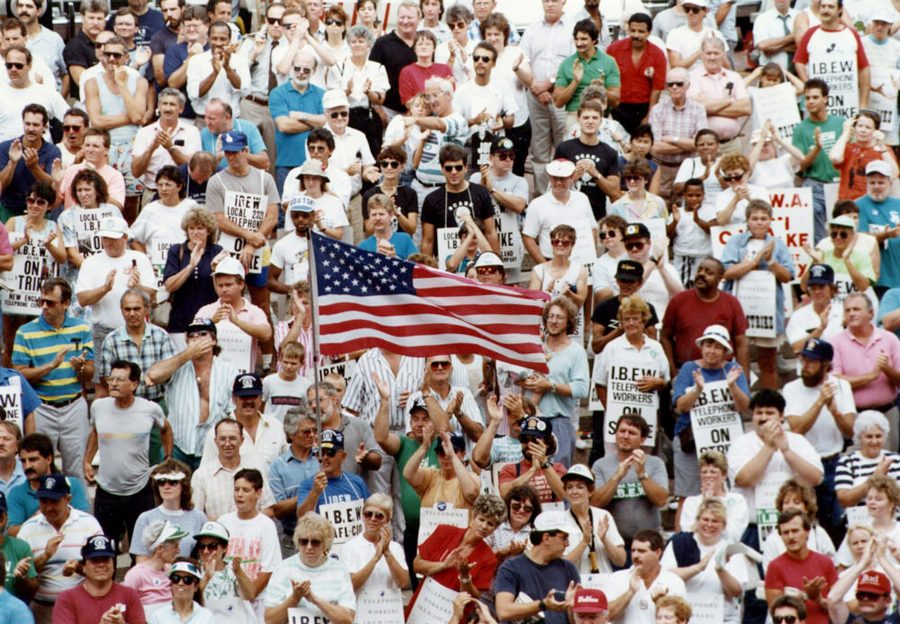A New Idea for New Union Organizing
Unions don’t organize enough people. Their structure is the problem.
Hamilton Nolan

Here are four propositions about unions that are, I think, indisputable:
1. The single greatest crisis facing unions is the long term decline in union density. Once upon a time, one in three American workers was a union member. Now it’s one in ten. That figure has been steadily going down for decades. If we don’t make it start going up again, organized labor is on a slow path to death.
2. Unions are more popular today than they have been since 1965. There are tens of millions of Americans who like unions, and who would like to have a union, but who are not union members. We also happen to have a pro-union president and a labor-friendly NLRB. The opportunity for new union organizing right now is historically strong.
3. The only way to take advantage of this opportunity to organize millions of new union members is… to do the organizing. The number of new unions that spontaneously organize themselves is very small. To raise union density, there must be many, many more union organizers out there organizing, translating the grassroots enthusiasm into actual new unions.
4. The existing institutions that are responsible for flooding the streets with all of those new union organizers are unions. They are not doing it. Nor have they been doing it for decades. We know this not only by the fact that they are not spending adequate money on organizing, but, more directly, by the fact that union density keeps going down. The numbers are proof.
Why is it that unions, the only things that exist to do new union organizing, do not organize enough new union members? Unions will tell you that there are many reasons — hostile labor laws, corporate union-busting, difficult political climates. There is some truth to all of these explanations, but they are also a bit like stopping and sitting down while a wild dog is chasing you, because running is tiring. Sure it is, but that’s not much consolation when you’re dead. There always have been, and always will be, political and corporate forces hostile to unions. That does not change the fact that unions must find a way to organize, or else die.
Apart from the shifting social and political and economic conditions of the world, there is an inherent structural reason why unions do not organize enough. It is this: Unions are supported by dues money paid by current members. The overwhelming internal political incentive of any union’s leadership is to serve the needs of current members. (And indeed they must!) But this ensures that new organizing — which is to say, spending the dues money of current members on work that benefits people who are not members — will always lack a natural internal political constituency inside of unions, other than the minority of people who are ideologically motivated by a belief in the labor movement.
This is just the union version of the dynamic that is familiar from every local government: People want their tax money spent in ways that benefit them. It’s a form of selfishness, but the sort of natural low-level selfishness that is a part of human nature. In unions, this tendency manifests itself by underspending on new organizing. The current members always have needs, and their needs get prioritized. The result has been a half century of declining union density, with the vast majority of people having no union to protect them.
This general situation is familiar to generations of union radicals who have tried and (usually) failed to harangue unions into organizing the masses. Continuing to struggle against these built-in structural barriers is not the best use of our precious time. Today’s favorable conditions for new organizing won’t last. Instead, what we need is a new structure that can make new organizing happen without being held back by the internal politics of unions.
The bulk of new union organizing, therefore, needs to be moved out of unions and into its own dedicated thing. We need a new institution that does a single task: New organizing. An institution staffed by organizers whose single job is to help non-union workers unionize their workplaces. A new organizing center that only does new organizing.
When the workers have won their unions, they can be placed into existing unions that can do the contracts and grievances and enforcement and all of the other normal union stuff. But new organizing—the job on which the future of the entire labor movement depends — is too important to be relegated to an afterthought within unions that are focused on catering to current members. We need to build something new that does not have any mixed incentives. Its success can be judged entirely on the number of people it unionizes.
This sort of national organizing center would require a lot of funding. The obvious place for it would be inside of an existing national labor group like the AFL-CIO. And in fact the AFL-CIO last year created the “Center for Transformational Organizing” (CTO) funded by a dues increase on member unions, that is supposed to do, you know, transformational organizing. The structure of this is promising, but the reality of it is not.
The CTO has existed for a year, and has not done any transformational organizing. In light of the urgency of the task, its $11 million could have been spent in an afternoon: Pick five or six existing unions that are actually doing organizing, and divide the money between them, to increase their organizing. (I can give you a list! Call me!) If the CTO is not going to do this, they should be deeply immersed in big organizing campaigns of their own already. The lack of results so far is not inspiring.
Another model that already exists is the Emergency Workplace Organizing Center (EWOC), a joint project of the Democratic Socialists of America and the United Electrical, Radio and Machine Workers of America. It is essentially a volunteer-driven coalition of organizers that will help anyone who contacts them start the organizing process. EWOC has the spirit that we need, but not the scale. In terms of resources, EWOC is a tent set up in the backyard, when what we need is a skyscraper.
Imagine a new organization that combines the everyone-in ideological commitment of EWOC with the structural advantages of the CTO. If existing unions directed much of their current organizing budgets into one big pot, the funding for such an organization would be significant. It could hire an army of organizers. It could scale nationally. It could target industries aggressively, and it could promote an EWOC-like open door that would help any worker anywhere start the organizing process. Most importantly, it would not suffer from the mixed incentives that have historically restrained unions from doing enough organizing. It would do numbers, or it would be a failure. Simple.
Most of today’s unions are already failing, but since union leaders are not being judged on the metric of new organizing, their jobs are secure, and they can keep on failing in peace. With a dedicated organizing center, that would not be the case.
Once you create this new organization, fund it, staff it, and give it independence, it can also seek out new funding streams on its own. Its annual budget would need to be big. But considering the fact that our job is to organize the work forces of companies that are worth billions or trillions of dollars, we should not be staggered by big numbers. It is money well spent.
Organizing is hard work. It will be hard whether we do an inadequate, ad hoc job of it, as we are now, or whether we do it systematically and wisely, as I am proposing. What we know is this: We must do a lot more new organizing, and our current system for doing so doesn’t work. Time to try something different.
If we, the American labor movement, continue to fail, we will have no one to blame but our own laziness and obstinacy. The people who suffer for our sins will be all the workers who need a union, but will never get one, because we never got around to helping them.
Hamilton Nolan is a labor writer for In These Times. He has spent the past decade writing about labor and politics for Gawker, Splinter, The Guardian, and elsewhere. More of his work is on Substack.







